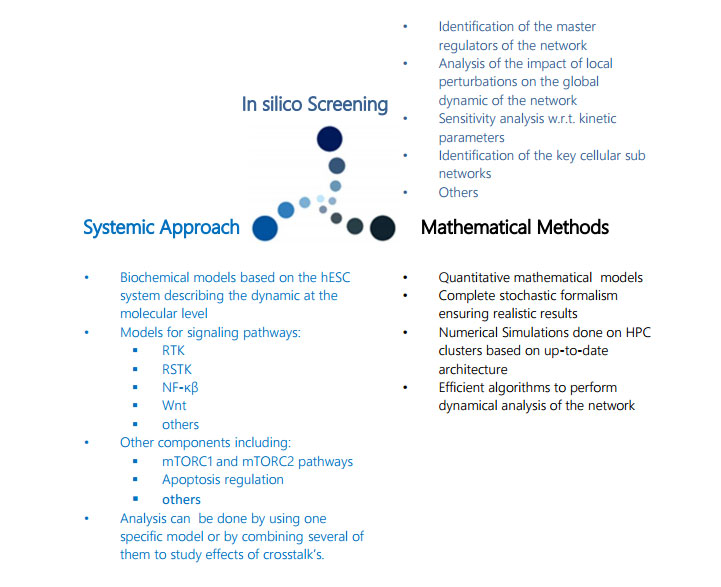
Biochemical reaction networks and the study of the relationships between their dynamical behaviors and structural properties
Introduction
This website is a work in progress. The purpose is to discuss dynamical properties of chemical reaction networks and relationships with their structural properties. This topic can be formally discussed using various mathematical tools allowing study of symbolic ordinary differential equations.
Systems of coupled chemical reactions are common in many fields, notably in biochemistry. Chemical reaction network theory (CRNT) is an area of applied mathematics that attempts to model the behavior of chemical and biochemical systems. This topic was first studied by Feinberg, Horn, and Jackson in the 1970s. The goal is to establish a reasonably general theory that can be easily used by engineers. Thus, one of the main focuses of the theory is about the existence and stability of steady state solutions. The chemical reaction network theory is a promising area that has attracted a growing research community since its foundation in the 70s. Important results are the deficiency theorems which states conditions required so that all solutions in the same compatibility class of chemical reaction networks obeying certain types of kinetics would converge to a unique equilibrium. This has remarkable implications for the dynamics of large classes of polynomial and power-law dynamical systems.
- Mathematical modeling with quantitative simulations provides our clients with insilico time series data of a selected set of molecules for different types of initial conditions and external perturbations
- Using insilico time series data, our Insilico Screening Services can identify master regulators and critical sub networks, providing our clients with a set of the most relevant targets for knockdown or inhibition/overexpression experiments

Results obtained with quantitative simulations are easily reproducible: we can test as many initial conditions as needed to give our clients a better overview of the global comportment of the cellular network of interest.
How does it work?

Stem cell biology, regenerative medicine, evolutionary theories of aging, biophysics, non-linear systems, non-equilibrium thermodynamics
Some Publications |
Read |
|---|---|
| The conundrum of human immune system "senescence" | Source |
| Artificial intelligence, drug repurposing and peer review | Source |
| The Advent of Generative Chemistry | Source |
| Lack of consensus on an aging biology paradigm? A global survey reveals an agreement to disagree, and the need for an interdisciplinary framework | Source |
| Web-based Tools for Drug Repurposing: Successful Examples of Collaborative Research | Source |
| Will Artificial Intelligence for Drug Discovery Impact Clinical Pharmacology? | Source |
| Latest advances in aging research and drug discovery | Source |
| Thermo-capillary effects along a deformable singular interface between two immiscible fluids | Source |
| Non-programmed (Nonadaptive) Aging Theories | Source |
| Artificial Intelligence for Aging and Longevity Research: Recent Advances and Perspectives | Source |
| A Note on Stochastic Modeling of Biological Systems: Automatic Generation of an Optimized Gillepsie Algorithm | Source |
| Entropy production, thermodynamic fluxes and transport coefficients of an interface between two electromagnetic fluids with spin | Source |
| Adversarial Threshold Neural Computer for Molecular De Novo Design | Source |
| Vive la radiorésistance!: Converging research in radiobiology and biogerontology to enhance human radioresistance for deep space exploration and colonization | Source |
| Chapter 3: Evolutionary Theories of Aging: A Systemic and Mechanistic Perspective | Source |
| A comparative review of computational methods for pathway perturbation analysis: Dynamical and topological perspectives | Source |
| The cornucopia of meaningful leads: Applying deep adversarial autoencoders for new molecule development in oncology | Source |
| In silico Pathway Activation Network Decomposition Analysis (iPANDA) as a method for biomarker development | Source |
| Design of efficient computational workflows for in silico drug repurposing | Source |
| Aging as an Optimization Between Cellular Maintenance Requirements and Evolutionary Constraints | Source |
| Forward and Reverse Genetics through Derivation of Haploid Mouse Embryonic Stem Cells | Source |
| Contribution to the dynamics of a deformable interface between two immiscible electromagnetically controllable fluids | Source |
Contact us |
|---|
E-mail